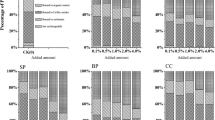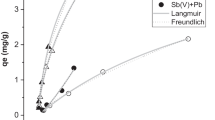Abstract
Phosphates can cost-effectively decrease the mobility of Pb in contaminated soils. However, Pb always coexists with other metals in soil, their competitive reactions with phosphates have not been tested. In this study, the abilities of KH2PO4, K2HPO4, and K3PO4 to stabilize Pb, Zn, and Cd in soils contaminated with a single metal or a ternary metal for different phosphorus/metal molar ratios were investigated. Results indicated that the stabilization efficiency of KH2PO4, K2HPO4, and K3PO4 for Pb, Zn, and Cd in single metal contaminated soil (P/M ratio 0.6) was 96.00%–98.74%, 33.76%–47.81%, and 9.50%–55.79%, respectively. Competitive stabilization occurred in the ternary system, Pb exhibited a strong competition, the stabilization efficiency of Zn and Cd reduced by 23.50%–31.64%, and 7.10%–39.26%, respectively. Pyromorphite and amorphous lead phosphate formed with excess KH2PO4 or K2HPO4 addition, while K3PO4 resulted in the formation of a hydroxypyromorphite precipitate. Amorphous Zn and Cd phosphates and hydroxides were the primary products. The immobilization rate of Zn and Cd depends on pH, and increased significantly in response to the excess phosphate application. This approach provides insight into phosphate-induced differences in stabilization efficiency in soils contaminated with multiple metals, which is of theoretical and engineering significance.

Similar content being viewed by others
References
Ahn J, Kang S, Hwang K, Kim H, Kim J, Song H, Hwang I. Evaluation of phosphate fertilizers and red mud in reducing plant availability of Cd, Pb, and Zn in mine tailings. Environmental Earth Sciences, 2015, 74(3): 2659–2668
Zhang Z, Guo G, Teng Y, Wang J, Rhee J S, Wang S, Li F. Screening and assessment of solidification/stabilization amendments suitable for soils of lead-acid battery contaminated site. Journal of Hazardous Materials, 2015, 288: 140–146
Fang Y, Cao X, Zhao L. Effects of phosphorus amendments and plant growth on the mobility of Pb, Cu, and Zn in a multi-metalcontaminated soil. Environmental Science and Pollution Research International, 2012, 19(5): 1659–1667
Sdiri A, Higashi T, Chaabouni R, Jamoussi F. Competitive removal of heavy metals from aqueous solutions by montmorillonitic and calcareous clays. Water, Air, and Soil Pollution, 2012, 223(3): 1191–1204
Cao X, Ma L Q, Rhue D R, Appel C S. Mechanisms of lead, copper, and zinc retention by phosphate rock. Environmental Pollution, 2004, 131(3): 435–444
Chen S, Xu M, Ma Y, Yang J. Evaluation of different phosphate amendments on availability of metals in contaminated soil. Ecotoxicology and Environmental Safety, 2007, 67(2): 278–285
Impellitteri C A. Effects of pH and phosphate on metal distribution with emphasis on As speciation and mobilization in soils from a lead smelting site. Science of the Total Environment, 2005, 345(1–3): 175–190
Corami A, Mignardi S, Ferrini V. Copper and zinc decontamination from single- and binary-metal solutions using hydroxyapatite. Journal of Hazardous Materials, 2007, 146(1–2): 164–170
Corami A, Mignardi S, Ferrini V. Cadmium removal from singleand multi-metal (Cd + Pb + Zn + Cu) solutions by sorption on hydroxyapatite. Journal of Colloid and Interface Science, 2008, 317 (2): 402–408
Ma L Q, Rao G N. Aqueous Pb reduction in Pb-contaminated soils by florida phosphate rocks.Water, Air, and Soil Pollution, 1999, 110 (1–2): 1–16
Hashimoto Y, Sato T. Removal of aqueous lead by poorlycrystalline hydroxyapatites. Chemosphere, 2007, 69(11): 1775–1782
Jalali M, Moradi F. Competitive sorption of Cd, Cu, Mn, Ni, Pb and Zn in polluted and unpolluted calcareous soils. Environmental Monitoring and Assessment, 2013, 185(11): 8831–8846
Miretzky P, Fernandez-Cirelli A. Phosphates for Pb immobilization in soils: a review. Environmental Chemistry Letters, 2008, 6(3): 121–133
Austruy A, Shahid M, Xiong T T, Castrec M, Payre V, Niazi N K, Sabir M, Dumat C. Mechanisms of metal-phosphates formation in the rhizosphere soils of pea and tomato: environmental and sanitary consequences. Journal of Soils and Sediments, 2014, 14(4): 666–678
Cao X, Liang Y, Zhao L, Le H. Mobility of Pb, Cu, and Zn in the phosphorus-amended contaminated soils under simulated landfill and rainfall conditions. Environmental Science and Pollution Research International, 2013, 20(9): 5913–5921
Zhang Z, Ren J, Wang M, Song X, Zhang C, Chen J, Li F, Guo G. Competitive immobilization of Pb in an aqueous ternary-metals system by soluble phos9phates with varying pH. Chemosphere, 2016, 15: 58–65
Barrett J E, Taylor K G, Hudson-Edwards K A, Charnock J M. Solid-phase speciation of Pb in urban road dust sediment: a XANES and EXAFS study. Environmental Science & Technology, 2010, 44 (8): 2940–2946
USEPA. USEPA 1311 SW-846. Test Methods for Evaluating Solid Wastes. Physical/Chemical Methods. Washington DC: US Environmental Protection Agency, 1991
Vandenhove H, Vanhoudt N, Duquène L, Antunes K, Wannijn J. Comparison of two sequential extraction procedures for uranium fractionation in contaminated soils. Journal of Environmental Radioactivity, 2014, 137: 1–9
Wang L, Putnis C V, Ruiz-Agudo E, King H E, Putnis A. Coupled dissolution and precipitation at the cerussite-phosphate solution interface: implications for immobilization of lead in soils. Environmental Science & Technology, 2013, 47(23): 13502–13510
Chen X B, Wright J V, Conca J L, Peurrung L M. Effects of pH on heavy metal sorption on mineral apatite. Environmental Science & Technology, 1997, 31(3): 624–631
Ma Q Y, Traina S J, Logan T J, Ryan J A. Effects of Aqueous Al, Cd, Cu, Fe(II), Ni, and Zn on Pb Immobilization by Hydroxyapatite. Environmental Science & Technology, 1994, 28(7): 1219–1228
Hodson M E, Valsami-Jones É, Cotter-Howells J D. Bonemeal additions as a remediation treatment for metal contaminated soil. Environmental Science & Technology, 2000, 34(16): 3501–3507
Matusik J, Bajda T, Manecki M. Immobilization of aqueous cadmium by addition of phosphates. Journal of Hazardous Materials, 2008, 152(3): 1332–1339
Shevade A V, Erickson L, Pierzynski G, Jiang S. Formation and stability of substituted pyromorphite: A molecular modeling study. Journal of Hazardous Substance Research, 2002(3): 1–11
Bosso S T, Enzweiler J, Angélica R S. Lead bioaccessibility in soil and mine wastes after immobilization with phosphate. Water, Air, and Soil Pollution, 2008, 195(1–4):257–273
Cao X, Wahbi A, Ma L, Li B, Yang Y. Immobilization of Zn, Cu, and Pb in contaminated soils using phosphate rock and phosphoric acid. Journal of Hazardous Materials, 2009, 164(2–3): 555–564
Gupta D K, Chatterjee S, Datta S, Veer V, Walther C. Role of phosphate fertilizers in heavy metal uptake and detoxification of toxic metals. Chemosphere, 2014, 108: 134–144
Ma Q Y, Logan T J, Traina S J. Lead immobilization from aqueous solutions and contaminated soils using phosphate rocks. Environmental Science & Technology, 1995, 29(4): 1118–1126
Acknowledgments
This study was funded by the National High Technology Research & Development Program of China (Grant No. 2013AA06A206) and the Environmental Protection Special Scientific Research Fund for Chinese Public Welfare Industry (No. 201509048).
Author information
Authors and Affiliations
Corresponding authors
Rights and permissions
About this article
Cite this article
Ren, J., Zhang, Z., Wang, M. et al. Phosphate-induced differences in stabilization efficiency for soils contaminated with lead, zinc, and cadmium. Front. Environ. Sci. Eng. 12, 10 (2018). https://doi.org/10.1007/s11783-018-1006-2
Received:
Revised:
Accepted:
Published:
DOI: https://doi.org/10.1007/s11783-018-1006-2




